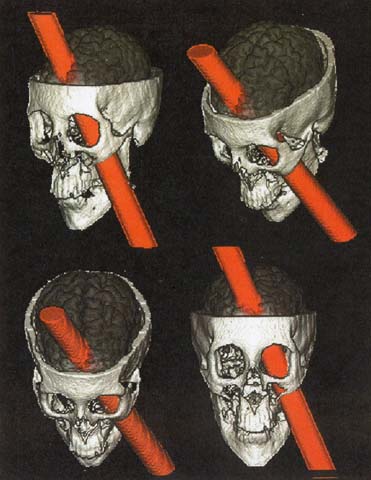In 1848, Phineas Gage, an American railroad worker, was impaled through the skull by a 43-inchlong tamping iron when the explosives he was working with went off prematurely.
1848年,美國鐵路工人菲尼亞斯·蓋奇工作時,爆炸物過早引爆,導致他被一根43英寸長的鐵夯刺穿頭骨。
He survived, but his personality was permanently altered.
他活了下來,但性格卻發生了永久性地改變。
In a paper titled "Recovery From the Passage of an Iron Bar Through the Head," his doctor wrote that Gage's "animal propensities" had emerged and described him as using the "grossest profanity."
在一篇題為《經歷鐵棒穿過頭部后的恢復》的論文中,他的醫生寫道,蓋奇顯露出“動物傾向”,并描述他使用“最粗俗的臟話”。
Modern research has shown that the tamping iron destroyed key areas of the brain involved in inhibition—the same areas that were altered in the depressed patients who'd committed suicide.
現代研究表明,鐵夯破壞了大腦中與抑制有關的關鍵區域,這些區域與自殺的抑郁癥患者發生改變的腦區相同。
For the group, this was a clue that the differences in the brain of suicidal patients were anatomically important.
對他們來說,這是一個線索,它表明自殺患者大腦的差異在解剖學上是重要的。
"Most people inhibit suicide. They find a reason not to do it," Underwood says.
“大多數人都會抑制住自殺,能找到不這么做的理由,”安德伍德說。
Thanks to subtle changes in the part of the brain that might normally control inhibition and top-down control, people who kill themselves "don't find a reason not to do it," he says.
由于大腦中通常控制抑制和自上而下控制的部分發生細微變化,自殺的人“找不到不這么做的理由”。
About eight years ago, Mann saw ketamine research taking off in other corners of the scientific world and added the drug to his own work.
大約八年前,曼恩看到氯胺酮的研究在科學界的其他領域取得了進展,就把這種藥物加到自己的研究中。
In one trial, his group found that ketamine treatment could ease suicidal thoughts in 24 hours more effectively than a control drug.
在一項試驗中,他的研究小組發現氯胺酮治療與對照藥物相比,能在24小時內更有效地緩解自殺念頭。

Crucially, they found that the antisuicidal effects of ketamine were to some extent independent of the antidepressant effect of the drug, 關鍵是,他們發現氯胺酮的抗自殺作用在某種程度上獨立于藥物的抗抑郁作用,
which helped support their thesis that suicidal impulses aren't necessarily just a byproduct of depression.
這有助于支持他們的觀點,即自殺沖動不一定只是抑郁癥的副產物。
It was this study, led by Michael Grunebaum, a colleague of Mann's, that made a believer of Joe Wright.
正是這項由曼恩的同事邁克爾·格倫鮑姆負責的研究,使喬·賴特相信了這種觀點。
In 2000, the National Institutes of Health hired Charney to run both mood disorder and experimental drug research. It was the perfect place for him to forge ahead with ketamine.
2000年,美國國家衛生研究院(NIH)聘請查尼進行情緒障礙和實驗藥物研究,這是他采用氯胺酮推進研究的理想之地。
There he did the work to replicate what he and his colleagues at Yale had discovered.
他在那里進行研究,再造了他和耶魯大學的同事們發現的研究結果。
In a study published in 2006, led by researcher Carlos Zarate Jr., who now oversees NIH studies of ketamine and suicidality, an NIH team found that patients had "robust and rapid antidepressant effects" from a single dose of the drug within two hours.
小卡洛斯·扎拉特目前負責監督NIH對氯胺酮和自殺的研究,在2006年發表的一項研究中,由他負責的研究小組發現,患者在兩小時內單次用藥會產生“強勁又快速的抗抑郁作用”。
"We could not believe it. In the first few subjects we were like, 'Oh, you can always find one patient or two who gets better,'" Zarate recalls.
扎拉特回憶道:“我們無法相信這個結果。對于前幾個被試,我們會說,‘哦,總能找到一兩個病情好轉的病人。’”
In a 2009 study done at Mount Sinai, patients suffering from treatment-resistant depression showed rapid improvement in suicidal thinking within 24 hours.
2009年在西奈山進行的一項研究中,患有抗治療抑郁癥的患者在24小時內自殺性思維迅速出現改善。
The next year, Zarate's group demonstrated antisuicidal effects within 40 minutes. "That you could replicate the findings, the rapid findings, was quite eerie," Zarate says.
第二年,扎拉特的研究小組證實了該藥在40分鐘內的抗自殺效果。“可以重復求證這些研究結果,見效速度非常快,相當奇怪,”扎拉特說。












